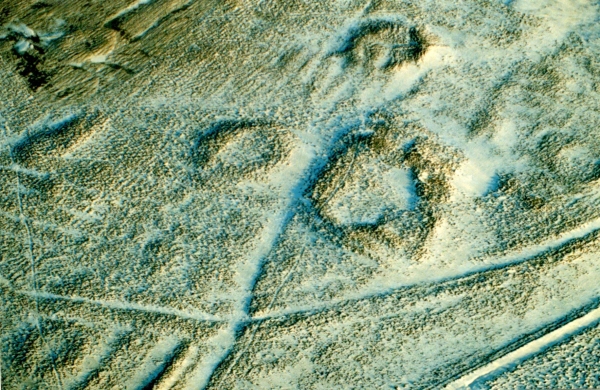Mysterious rings on the tip of Seltjarnarnes peninsula, near the Örfirisey nature preserve, just east of downtown Reykjavík, could be ruins of Viking Age structures, built by Irish settlers. The rings have not been the subject of systematic archaeological excavations, but local engineering geologist, Þorgeir S. Helgason, believes they could point to a Celtic and Irish presence among the Viking Age settlers of Iceland.
Discovered in the 1980s, dated to the Viking Age
Nothing is known about the origins or nature of the rings which were only discovered in the 1980s. They are not visible from the ground, but can be seen from the air under certain circumstances.
Read more: News report: The Viking Age settlement that is emerging in downtown Reykjavík
Read more: Map: The Viking Age settlement remains in downtown Reykjavík

The only academic studies which have been conducted at the site were performed by the National Museum in the late 1990s which revealed that the rings had been constructed shortly after the settlement layer of tephra fell.
Celtic settlers among the Norse Vikings?
The settlement layer is a layer of tephra, produced by a volcanic eruption in the Torfajökull glacier area which has been dated to around the year in 871, a date which fits with the 874 date given for the settlement of Iceland according to the Sagas. This indicates that the rings are remainders of structures built during the settlement of Iceland.
Numerous studies, including C14 radiocarbon dating has suggested that the settlement of Iceland began much earlier, perhaps as much as 100 before Ingólfur Arnarson settled in Reykjavík, according to Landnámabók, the Book of Settlements. This would mean that even more time passed from the actual settlement of Iceland and the writing of The Book of Settlements and the Sagas, allowing for more details to get lost in the mists of time.

Some historians and archaeologists, including Þorvaldur Friðriksson, believe that among these details which the written sources leave out are significant Irish and Celtic influences. Þorvaldur has pointed to place names which seem to have Celtic roots, especially in South-West Iceland and the area around Faxaflói bay, as proof of a strong Celtic presence. Þorvaldur told Stöð 2 that the rings support this theory.
Possible sign of Celtic influences
Þorgeir told the local TV station Stöð 2 that while the rings are very unique in Iceland, they would be perfectly at home in the Irish landscape:
In Ireland this building tradition remains dominant until at least 1200. People built boundary walls of these sizes, just like those we see here. But the actual structures, outhouses or dwellings, were inside the boundary walls.
Þorgeir argues that the rings point to a stronger Celtic presence in the settlement of Iceland than what we find in the Sagas.
Mysterious rings on the tip of Seltjarnarnes peninsula, near the Örfirisey nature preserve, just east of downtown Reykjavík, could be ruins of Viking Age structures, built by Irish settlers. The rings have not been the subject of systematic archaeological excavations, but local engineering geologist, Þorgeir S. Helgason, believes they could point to a Celtic and Irish presence among the Viking Age settlers of Iceland.
Discovered in the 1980s, dated to the Viking Age
Nothing is known about the origins or nature of the rings which were only discovered in the 1980s. They are not visible from the ground, but can be seen from the air under certain circumstances.
Read more: News report: The Viking Age settlement that is emerging in downtown Reykjavík
Read more: Map: The Viking Age settlement remains in downtown Reykjavík

The only academic studies which have been conducted at the site were performed by the National Museum in the late 1990s which revealed that the rings had been constructed shortly after the settlement layer of tephra fell.
Celtic settlers among the Norse Vikings?
The settlement layer is a layer of tephra, produced by a volcanic eruption in the Torfajökull glacier area which has been dated to around the year in 871, a date which fits with the 874 date given for the settlement of Iceland according to the Sagas. This indicates that the rings are remainders of structures built during the settlement of Iceland.
Numerous studies, including C14 radiocarbon dating has suggested that the settlement of Iceland began much earlier, perhaps as much as 100 before Ingólfur Arnarson settled in Reykjavík, according to Landnámabók, the Book of Settlements. This would mean that even more time passed from the actual settlement of Iceland and the writing of The Book of Settlements and the Sagas, allowing for more details to get lost in the mists of time.

Some historians and archaeologists, including Þorvaldur Friðriksson, believe that among these details which the written sources leave out are significant Irish and Celtic influences. Þorvaldur has pointed to place names which seem to have Celtic roots, especially in South-West Iceland and the area around Faxaflói bay, as proof of a strong Celtic presence. Þorvaldur told Stöð 2 that the rings support this theory.
Possible sign of Celtic influences
Þorgeir told the local TV station Stöð 2 that while the rings are very unique in Iceland, they would be perfectly at home in the Irish landscape:
In Ireland this building tradition remains dominant until at least 1200. People built boundary walls of these sizes, just like those we see here. But the actual structures, outhouses or dwellings, were inside the boundary walls.
Þorgeir argues that the rings point to a stronger Celtic presence in the settlement of Iceland than what we find in the Sagas.







